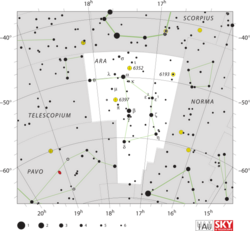Astronomy:Eta Arae
| Observation data Equinox J2000.0]] (ICRS) | |
|---|---|
| Constellation | Ara |
| Right ascension | 16h 49m 47.15653s[1] |
| Declination | –59° 02′ 28.9575″[1] |
| Apparent magnitude (V) | 3.76[2] |
| Characteristics | |
| Spectral type | K5 III[3] |
| U−B color index | +1.93[2] |
| B−V color index | +1.57[2] |
| Astrometry | |
| Radial velocity (Rv) | +9.0[4] km/s |
| Proper motion (μ) | RA: +39.73[1] mas/yr Dec.: –24.91[1] mas/yr |
| Parallax (π) | 10.90 ± 0.20[1] mas |
| Distance | 299 ± 5 ly (92 ± 2 pc) |
| Absolute magnitude (MV) | −1.14±0.14[5] |
| Details[6] | |
| Mass | 1.12±0.16 M☉ |
| Radius | 40.44±2.62 R☉ |
| Luminosity | 575 L☉ |
| Surface gravity (log g) | 1.06±0.06 cgs |
| Temperature | 4,147±29 K |
| Metallicity [Fe/H] | −0.47±0.03 dex |
| Rotational velocity (v sin i) | 1.55±0.55 km/s |
| Age | 4.98±1.86 Gyr |
| Other designations | |
| Database references | |
| SIMBAD | data |
Eta Arae, Latinized from η Arae, is the Bayer designation for a single [8] star in the southern constellation of Ara. It is approximately 299 light-years (92 parsecs) from Earth and is visible to the naked eye with an apparent visual magnitude of 3.76.[2] The star is moving away from the Sun with a radial velocity of +9 km/s.[4]
The spectrum of this star matches a stellar classification of K5 III,[3] indicating that, at an estimated age of five billion years,[6] it has reached the giant star stage of its evolution. With 1.12 times the mass of the Sun, it has an outer envelope that has expanded to 40 times the Sun's radius.[6] The star is now spinning so slowly that it takes more than eleven years to complete a single rotation.[9] Eta Arae is radiating energy into space from its photosphere with 575 times the Sun's luminosity at an effective temperature of 4,147 K,[6] giving it the orange-hued glow of a K-type star.[10]
It has a magnitude 13.5 optical companion, located 23.4 arcseconds away along a position angle of 118°, as of 2000.[11]
References
- ↑ 1.0 1.1 1.2 1.3 1.4 van Leeuwen, F. (November 2007), "Validation of the new Hipparcos reduction", Astronomy and Astrophysics 474 (2): 653–664, doi:10.1051/0004-6361:20078357, Bibcode: 2007A&A...474..653V.
- ↑ 2.0 2.1 2.2 2.3 Johnson, H. L. et al. (1966), "UBVRIJKL photometry of the bright stars", Communications of the Lunar and Planetary Laboratory 4 (99): 99, Bibcode: 1966CoLPL...4...99J.
- ↑ 3.0 3.1 Houk, Nancy (1978), Michigan catalogue of two-dimensional spectral types for the HD stars, 1, Ann Arbor: Dept. of Astronomy, University of Michigan, Bibcode: 1975mcts.book.....H.
- ↑ 4.0 4.1 Wilson, Ralph Elmer (1953), "General catalogue of stellar radial velocities", Carnegie Institute Washington D.C. Publication (Carnegie Institution of Washington), Bibcode: 1953GCRV..C......0W.
- ↑ da Silva, L. et al. (November 2006), "Basic physical parameters of a selected sample of evolved stars", Astronomy and Astrophysics 458 (2): 609–623, doi:10.1051/0004-6361:20065105, Bibcode: 2006A&A...458..609D.
- ↑ 6.0 6.1 6.2 6.3 Jofré, E.; Petrucci, R.; Saffe, C.; Saker, L.; de la Villarmois, E. Artur; Chavero, C.; Gómez, M.; Mauas, P. J. D. (2015). "Stellar parameters and chemical abundances of 223 evolved stars with and without planets". Astronomy & Astrophysics 574: A50. doi:10.1051/0004-6361/201424474. Bibcode: 2015A&A...574A..50J.
- ↑ eta Ara.
- ↑ Eggleton, P. P.; Tokovinin, A. A. (September 2008), "A catalogue of multiplicity among bright stellar systems", Monthly Notices of the Royal Astronomical Society 389 (2): 869–879, doi:10.1111/j.1365-2966.2008.13596.x, Bibcode: 2008MNRAS.389..869E.
- ↑ Setiawan, J. et al. (July 2004), "Precise radial velocity measurements of G and K giants. Multiple systems and variability trend along the Red Giant Branch", Astronomy and Astrophysics 421: 241–254, doi:10.1051/0004-6361:20041042-1, Bibcode: 2004A&A...421..241S.
- ↑ "The Colour of Stars", Australia Telescope, Outreach and Education (Commonwealth Scientific and Industrial Research Organisation), December 21, 2004, http://outreach.atnf.csiro.au/education/senior/astrophysics/photometry_colour.html, retrieved 2012-06-24.
- ↑ Mason, B. D.; Wycoff, G. L. I.; Hartkopf, W. I. (2008), Washington Visual Double Star Catalog, 2006.5 (WDS), U. S.Naval Observatory, Washington D.C., http://ad.usno.navy.mil/wds/, retrieved 2017-12-08
External links
 |


